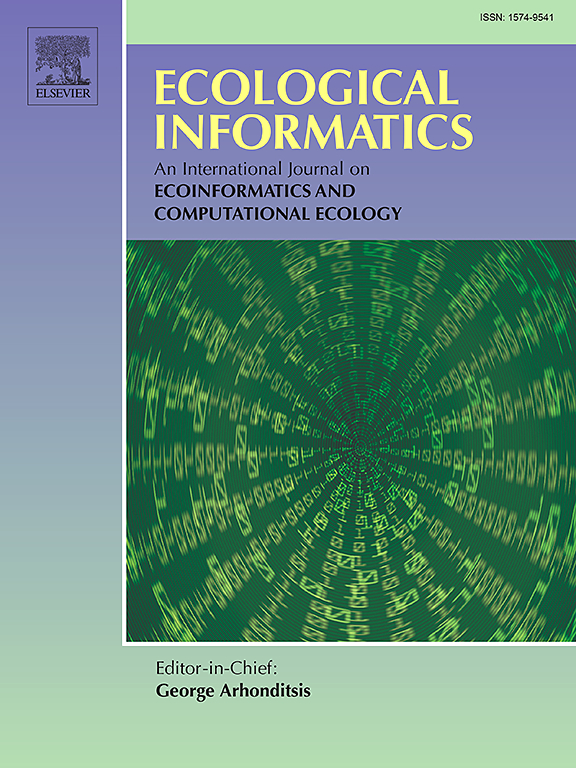利用卫星和辅助数据在1公里空间分辨率下无缝绘制全球日平均气温(SGM_DMAT)的新方案
IF 7.3
2区 环境科学与生态学
Q1 ECOLOGY
引用次数: 0
摘要
日平均气温是反映气候变化的重要指标。无缝的全球DMAT地图将大大提高我们对陆地气象和气候条件的认识。本研究提出了一种新的方案——无缝全球日平均气温映射(SGM_DMAT)。sgm_dat方案包括两个关键阶段:晴空条件下的dat估算和多云条件下的缺失值重构,分别以2020 - 2022年的数据作为校准数据和2023年的数据作为验证数据。结果表明,结合所有有效的中分辨率成像光谱仪(MODIS) TERRA/AQUA在晴空条件下的昼夜地表温度(LST)观测数据,并在阴天的参考图像中应用时空分析技术,可以确保DMAT估计的鲁棒性和无缝性。其中,选择极端梯度增强(Extreme Gradient Boosting, XGBoost)作为DMAT估计的最优模型。最优特征数据集包括卫星衍生的地表温度、纬度、经度、海拔高度、月份和日期。最优校准数据集包括所有有效校准数据(AVCD)。此外,利用不同的LST组合建立了DMAT晴空估计模型的优先级顺序。最后,生成了2020-2023年期间DMAT的鲁棒无缝全球地图。对于全球无缝映射产品,R2为0.956,RMSE为2.825°C, MAE为1.985°C。本文提出的sgm_dat方案可以为气象站点不足地区的dat估算提供帮助。无缝的全球DMAT产品具有广泛的适用性,包括趋势分析,城市热岛研究,以及极端温度导致的作物胁迫评估。本文章由计算机程序翻译,如有差异,请以英文原文为准。
A novel scheme for seamless global mapping of daily mean air temperature (SGM_DMAT) at 1-km spatial resolution using satellite and auxiliary data
The daily mean air temperature (DMAT) is an essential descriptor of climate change. Seamless global DMAT maps will significantly improve our knowledge of terrestrial meteorological and climatic conditions. This study proposes a novel scheme, Seamless Global Mapping of Daily Mean Air Temperatures (SGM_DMAT). The SGM_DMAT scheme comprises two key phases: Estimating DMAT under clear-sky conditions, and reconstructing missing values under cloudy conditions using data from 2020 to 2022 as the calibration dataset and data in 2023 as the validation dataset. The results demonstrate that combining all valid Moderate Resolution Imaging Spectroradiometer (MODIS) TERRA/AQUA daytime and nighttime land surface temperature (LST) observations under clear-sky conditions, and applying spatial temporal analysis techniques with reference images for cloudy days, ensures robust and seamless DMAT estimation. Specifically, the Extreme Gradient Boosting (XGBoost) was selected as the optimal model of DMAT estimation. The optimal feature dataset includes satellite-derived LSTs, latitude, longitude, elevation above sea level, month, and day of year. The optimal calibration dataset comprises all valid calibration data (AVCD). Additionally, the priority order of DMAT clear-sky estimation models was established using different LST combinations. Finally, robust and seamless global maps of DMAT were generated for the period 2020–2023. For globally seamless mapping products, the R2 was 0.956, with an RMSE of 2.825 °C and a MAE of 1.985 °C. The proposed SGM_DMAT scheme may aid DMAT estimation in regions that lack sufficient meteorological stations. The seamless global DMAT products have broad applicability including in trend analysis, urban heat island research, and assessment of crop stress due to temperature extremes.
求助全文
通过发布文献求助,成功后即可免费获取论文全文。
去求助
来源期刊

Ecological Informatics
环境科学-生态学
CiteScore
8.30
自引率
11.80%
发文量
346
审稿时长
46 days
期刊介绍:
The journal Ecological Informatics is devoted to the publication of high quality, peer-reviewed articles on all aspects of computational ecology, data science and biogeography. The scope of the journal takes into account the data-intensive nature of ecology, the growing capacity of information technology to access, harness and leverage complex data as well as the critical need for informing sustainable management in view of global environmental and climate change.
The nature of the journal is interdisciplinary at the crossover between ecology and informatics. It focuses on novel concepts and techniques for image- and genome-based monitoring and interpretation, sensor- and multimedia-based data acquisition, internet-based data archiving and sharing, data assimilation, modelling and prediction of ecological data.
 求助内容:
求助内容: 应助结果提醒方式:
应助结果提醒方式:


